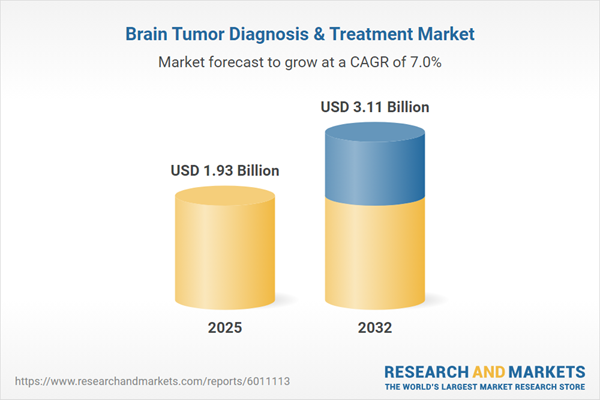Speak directly to the analyst to clarify any post sales queries you may have.
The Brain Tumor Diagnosis & Treatment Market is redefining the standards of neurological care, propelled by advanced diagnostics, therapeutic innovation, and pivotal collaboration among healthcare stakeholders. This comprehensive market analysis equips senior leaders with strategic perspectives to drive decision-making in a landscape where ongoing innovation consistently shapes patient management.
Market Snapshot: Brain Tumor Diagnosis & Treatment Market Growth
The global Brain Tumor Diagnosis & Treatment Market grew from USD 1.80 billion in 2024 to USD 1.93 billion in 2025. With a robust CAGR of 7.04%, it is projected to reach USD 3.11 billion by 2032.
These growth trends reflect rising prevalence, rapidly evolving therapeutic modalities, and investments in precision medicine across key healthcare territories.Scope & Segmentation of the Market
This report provides granular insights and revenue forecasts across multiple market dimensions, facilitating high-impact strategy formation:
- Treatment Type: Chemotherapy (combination therapies, nitrosoureas, temozolomide), Immunotherapy (CAR T-cell therapy, checkpoint inhibitors, vaccines), Radiotherapy (brachytherapy, external beam radiotherapy, stereotactic radiosurgery), Surgery, Targeted Therapy (bevacizumab, mTOR inhibitors, tyrosine kinase inhibitors)
- Diagnosis Type: Biopsy (open biopsy, stereotactic biopsy), Imaging (computed tomography, magnetic resonance imaging, positron emission tomography, ultrasound), Molecular Diagnostics (gene expression profiling, next generation sequencing, PCR-based assays)
- End User: Diagnostic centers, hospitals, research institutes, specialty clinics
- Tumor Type: Glioma (astrocytoma, glioblastoma, oligodendroglioma), medulloblastoma, meningioma, pituitary tumor (craniopharyngioma, pituitary adenoma)
- Region: Americas (United States, Canada, Mexico, Brazil, Argentina, Chile, Colombia, Peru), Europe, Middle East & Africa (United Kingdom, Germany, France, Russia, Italy, Spain, Netherlands, Sweden, Poland, Switzerland, United Arab Emirates, Saudi Arabia, Qatar, Turkey, Israel, South Africa, Nigeria, Egypt, Kenya), Asia-Pacific (China, India, Japan, Australia, South Korea, Indonesia, Thailand, Malaysia, Singapore, Taiwan)
- Leading Companies: Siemens Healthineers AG, GE Healthcare LLC, Koninklijke Philips N.V., Elekta AB, Varian Medical Systems, Inc., Accuray Incorporated, Roche Holding AG, Novartis AG, Merck & Co., Inc., Novocure Limited
Key Takeaways for Strategic Decision-Makers
- Integration of molecular diagnostics and imaging advances has enabled faster, more accurate tumor characterization, supporting precision-targeted clinical pathways for improved patient outcomes.
- Emerging immunotherapeutic modalities, including engineered cell therapies and checkpoint inhibitors, are expanding therapeutic options and guiding investment toward translational research and manufacturing scale.
- Segment-specific approaches are vital: various therapy and diagnostic segments demand specialized operational expertise, technology investments, and tailored resource allocation strategies.
- Collaboration among stakeholders—hospitals, research institutes, and industry—plays a critical role in the real-world adoption of breakthrough technologies and in optimizing clinical trial design.
- Regional market variances highlight the importance of aligning go-to-market and partnership strategies with local regulatory, economic, and healthcare ecosystem dynamics.
Tariff Impact on Supply Chains and Operations
The 2025 United States tariff adjustments increased duties on radiotherapy equipment and imaging technology imports, raising costs and prompting healthcare providers to reassess supplier relationships. Pharmaceutical supply chains have faced longer lead times and higher expenses for core ingredients, encouraging manufacturers to diversify sourcing and adopt contingency planning. These policy changes are catalyzing local production investments and flexible digital logistics deployments, underlining the essential connection between trade policies, supply chain resilience, and clinical service continuity.
Methodology & Data Sources
Insights are underpinned by in-depth interviews with healthcare professionals and executives, alongside a comprehensive review of peer-reviewed literature, government reports, and clinical trial registries. Analytical rigor is maintained through thematic coding, cross-validation, and scenario analysis, with an expert panel guiding data interpretation to ensure objectivity and reliability.
Why This Report Matters
- Enables executives to assess strategic opportunities across dynamic clinical, supply chain, and regulatory environments by delivering actionable, segmented intelligence.
- Supports informed investment and partnership decisions with robust segmentation and trend analyses grounded in industry best practices and validated primary sources.
Conclusion
This report synthesizes critical shifts in technology, supply chains, and regional markets that define the Brain Tumor Diagnosis & Treatment Market. Senior leaders can leverage these insights to navigate complexity, prioritize innovation, and enhance the value delivered across patient care pathways.
Additional Product Information:
- Purchase of this report includes 1 year online access with quarterly updates.
- This report can be updated on request. Please contact our Customer Experience team using the Ask a Question widget on our website.
Table of Contents
3. Executive Summary
4. Market Overview
7. Cumulative Impact of Artificial Intelligence 2025
Companies Mentioned
The companies profiled in this Brain Tumor Diagnosis & Treatment market report include:- Siemens Healthineers AG
- GE Healthcare LLC
- Koninklijke Philips N.V.
- Elekta AB
- Varian Medical Systems, Inc.
- Accuray Incorporated
- Roche Holding AG
- Novartis AG
- Merck & Co., Inc.
- Novocure Limited
Table Information
| Report Attribute | Details |
|---|---|
| No. of Pages | 185 |
| Published | October 2025 |
| Forecast Period | 2025 - 2032 |
| Estimated Market Value ( USD | $ 1.93 Billion |
| Forecasted Market Value ( USD | $ 3.11 Billion |
| Compound Annual Growth Rate | 7.0% |
| Regions Covered | Global |
| No. of Companies Mentioned | 11 |









